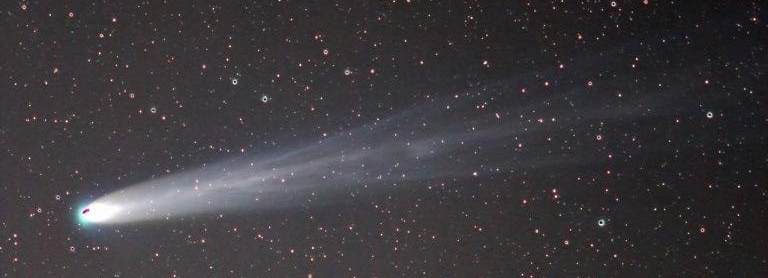
Section Director: Tim Cooper
Activity areas: Comets, Asteroids, Meteors
Publications: CAMnotes, Comet Observing Guide, Meteor Observing Guide (PDF)
Specialists & Collaborators: Kos Coronaios
Contact us: [ CAM assa.saao.ac.za ]
assa.saao.ac.za ]
Activity areas: Comets, Asteroids, Meteors
Publications: CAMnotes, Comet Observing Guide, Meteor Observing Guide (PDF)
Specialists & Collaborators: Kos Coronaios
Contact us: [ CAM
Alerts
- CAMnotes 2025 No. 1 January to March 2025 — 2024 Dec 26
- CAMnotes 2024 No. 4 October to December 2024 — 2024 Sep 29
- CAMnotes 2024 No. 3 July to September 2024 — 2024 Jun 29
- CAMnotes 2024 No. 2 April to June 2024 — 2024 Mar 29
- CAMnotes 2024 No. 1 January to March 2024 — 2023 Dec 28
- Possible outburst of Andromedid meteors on 2023 December 02 (download PDF) — 2023 Nov 06
- An observing campaign to search for meteoroids of Bennu at Earth — 2022 Dec 22
- Bright fireball seen from the Western Cape on Saturday 18 June 2022 — 2022 Jun 23
- Comet C/2021 A1 (Leonard) — 2022 Jan 21
Introduction
Comets, asteroids and meteors may be considered as the debris of the solar system. They are members of the group of objects known as Small Solar System Bodies, which are any solar system body too small to meet the definition of either a planet or dwarf planet. The CAM Section is involved in the observation of these bodies, which are important to our understanding of the formation and evolution of our solar system.
Definition of terms
The following definitions are from those accepted by the IAU.
- An asteroid, also known as a minor planet, is an irregularly shaped rocky body orbiting the Sun that does not meet the definition of either a planet or dwarf planet.
- A comet is a small body orbiting the Sun, and comprising a substantial fraction of its composition as volatile matter, which can sublimate under the effect of solar radiation to form a coma.
- A meteoroid is a solid natural object of a size roughly between 30 µm and 1m moving in, or coming from, interplanetary space.
- A meteor is the light and associated physical phenomena (heat, shock, ionization), which result from the high speed entry of a solid object from space into a gaseous atmosphere. A meteor brighter than visual magnitude –4 is termed a bolide or a fireball.
- A meteorite – is any natural solid object that survived the meteor phase in a gaseous atmosphere without being completely vaporized.
- A meteor shower is a group of meteors produced by meteoroids of the same meteoroid stream, and may be formed by either a comet or asteroid.
What observations can be made?
- Comets: for observations to be of scientific value the observer should concentrate on making estimates of the total visual magnitude of the comet (preferably made over the entire apparition to allow construction of a light curve), the diameter of the coma, the degree of condensation of the comet, and the length and position angle of the tail. Detailed visual descriptions, sketches and photographs of the comet should also be recorded. Further details are given in our Guide to Observing Comets.
- Asteroids: determination of size and shape by timing occultations of stars by asteroids, light curve studies to determine rotation rates.
- Meteors: visual counts in order to determine time of maxima and generate activity profiles of showers, recording of shower meteor magnitudes to determine population index, and plotting of meteors to determine radiant position and structure. In addition, the Section participates in global video monitoring networks, in order to detect new meteor streams and confirm showers listed by the IAU Meteor Data Centre (MDC). Find out more on the About Meteors page.
- Fireballs: any meteor of magnitude –4 or brighter is of great interest and should be reported! Please use the Report a Sighting page to share your sighting.
Comet compendium
- Comet C/2021 A1 (Leonard) 2021 Dec 27 — 27 December 2021
- Comet C/2021 A1 (Leonard) in Southern African skies — 28 December 2021
- Comet C/2020 F3 NEOWISE — March 2020
- C/2012 K1 (PANSTARRS) — 2014 June 19
- Observations of Comet C/2012 F6 (Lemmon) (MNASSA PDF) — 2013 Dec
- Comet Lovejoy, the Great Christmas Comet of 2011 (MNASSA PDF) — 2012 Feb
- Comet Lulin (MNASSA PDF) — 2009 Apr
- New mineral found in comet dust (MNASSA PDF) — 2008 Aug
- SOHO bags 1 500 comets (MNASSA PDF) — 2008 Aug
- The Great Comet of 2007 (MNASSA PDF) — 2007 Apr
- The Surprise Comet of 2007, 17P/Holmes (MNASSA PDF) — 2007 Dec
- The Brightness Behaviour of Comet C/2006 P1 McNaught (MNASSA PDF) — 2007 Dec
- Artificial comet over Cape Town (Greg Roberts) (MNASSA PDF) — 2006 Aug
- ASSA Observations of Comet 9P Tempel 1 (T.P. Cooper) (MNASSA PDF) — 2005 Dec
Meteor compendium
- Bolide over the Western Cape — 2021 August
- The Botswana super-bolide and meteorites from asteroid 2018 LA — 2021 April
- The Western Cape Bolide of 2019 January 16 — 2019 January
